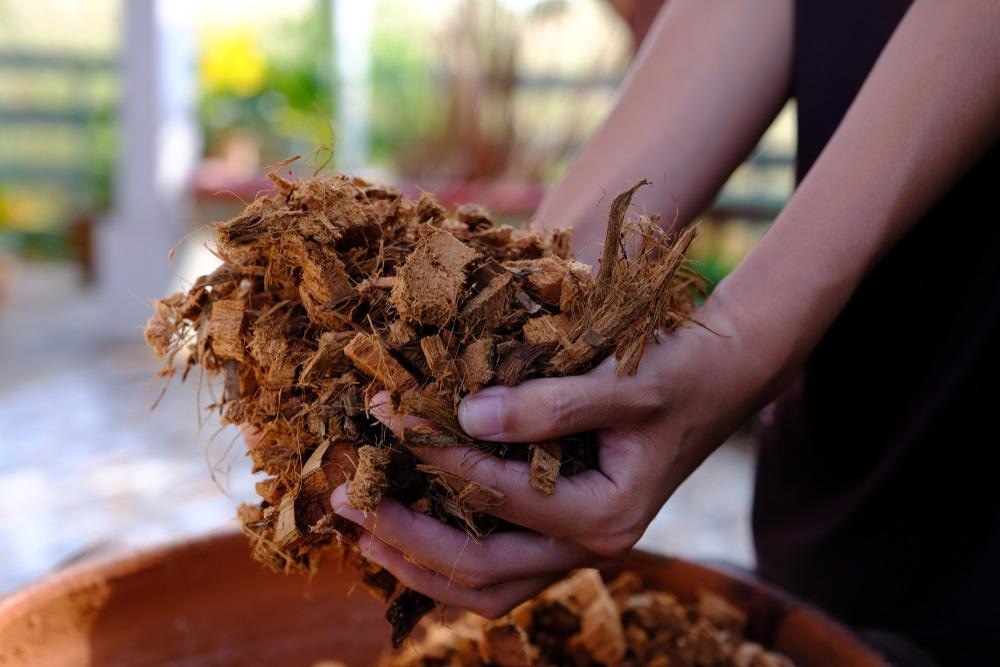In a paper printed in the journal Carbon, the coconut shell, a typical biomass residue, is mixed with magnetic particles to make a good quality microwave-absorbing nanocomposite.

Study: Electromagnetic wave absorbing properties of coconut shell-derived nanocomposite. Image Credit: EVANATTOZA/Shutterstock.com
Importance of EM Shielding and Absorbing Materials
As wireless communication technology advances, numerous electronic gadgets offer useful applications in everyday life. Simultaneously, it leads to the existence of very concentrated and elevated electromagnetic radiation. Abundant radiation in the frequency spectrum of 2-18 GHz, in particular, may cause major difficulties like channel noise, telecommunication disruption, and a hazard to people's health.
To minimize these negative impacts, electromagnetic interference shielding materials and electromagnetic absorption materials must be used. While electromagnetic interference shielding technologies protect interior electronics, additional outward effects exist.
To entirely eliminate this issue, efforts have been undertaken to produce a variety of microwave absorption substances. Previously, researchers used electrostatic assembly to create a core-shell C@Ni alloy. The magnetic particles significantly improved the absorption performance. In reality, microwave absorption materials must perform consistently over long durations, which necessitates that they are lightweight and resilient to corrosive environments.
Effectiveness of Carbon Materials
Carbon materials have gotten a lot of interest in the area of microwave absorption due to their exceptional qualities, including lightness, good conductivity, and the ease with which they may be formed into unique nanostructures. Carbon fiber, reduced graphene oxide, and carbon nanotubes (CNT), for instance, are thought to be particularly promising microwave absorption materials for usage.
Carbon-based materials may be built into specific nanostructures, which improves dielectric loss capacity owing to increased interfacial polarization. Nonetheless, creating typical carbon-based microwave absorption materials often entails complex synthesis procedures with substantial energy usage, such as electrochemical deposition, solvent evaporation, and phase separation.
These processes often need the use of costly and dangerous natural resources, which are more likely to trigger noticeable environmental damage. As a result, the carbon materials supply and preparation method must be optimized. As a result, novel carbon-based microwave absorbing materials with improved microwave absorption capabilities may be created using less expensive, more efficient, and reusable techniques.
Biomass and its Advantages
Biomass is a plentiful natural resource that is both clean and renewable. The notion of transforming waste biomass into high-performance microwave absorption compounds is also consistent with the notion of environmental sustainability. Generally, biomass may be used simply as a raw material in producing a biomass-based composite or transformed into carbon and employed as a biopolymer.
Biomass frequently contains unusual porosity patterns that aid in the transfer of water and other minerals throughout plant life. These characteristics are advantageous in the preparation of biomass-derived carbon with a variety of nanostructures and wide surface surfaces. The material's porous structure may efficiently manage absorptivity.
Limitations of Biomass
Owing to the abundance of surface functional groups of virgin biomass, surface modification of biomass-derived carbon is quite simple. Nonetheless, there is a significant issue with using biomass-derived nanotubes as a microwave absorbent material. The greater electrical conductance of pure carbon material aids in the dispersion of inner radiant waves, but it also causes an imbalance between carbon materials and open space.
Other microwave absorbing materials, including magnetic nanoparticles and dielectric properties, may be added to the surface of graphene sheets to alleviate this issue. The hydrothermal process was used to create C/CoNi compounds from bamboo fiber. On the face of the stimulated bamboo fibers, round copper nickel nanoparticles were evenly formed. The permeation was significantly increased, and the nanocomposite had an RLmin of -75.19 dB at 11.12 GHz.
Magnetic materials may efficiently enhance comparable permeability.Furthermore, certain biomasses are underused, such as the practicality of coconut shells, which are frequently disregarded. It is possible to try to turn these into usable materials.
A new nanocomposite from coconut shell (CS), typical biomass from agricultural leftovers that have not previously been described as a microwave absorbing material, was made as a low-cost and compact microwave absorbing material using a hydrothermal-calcination process in this study. The preparation procedure was quite straightforward, making it not only affordable but also simple to advertise on a big scale.
Outcomes of the Research
Coconut shell, a typical agricultural by-product, was turned into a low-cost carbon nanocomposite as a microwave absorbing material in this study. The nanomaterials were made up of a multilayer carbon matrix with magnetized Fe/Fe3C nanocrystals patterned on the top after hydrothermal process and decomposition.
In microwave absorption, PMCS clearly outperformed current, comparable materials. Overall, the research proposed a novel method for biomass conversion into ultralight, limited, high-quality carbon-based microwave absorbing materials.
Reference
Yang, S., Sun, X., Wang, S., Ning, Y., & Yuan, Y. (2022). Electromagnetic wave absorbing properties of coconut shell-derived nanocomposite. Carbon. Available at: https://doi.org/10.1016/j.carbon.2022.05.016
Disclaimer: The views expressed here are those of the author expressed in their private capacity and do not necessarily represent the views of AZoM.com Limited T/A AZoNetwork the owner and operator of this website. This disclaimer forms part of the Terms and conditions of use of this website.